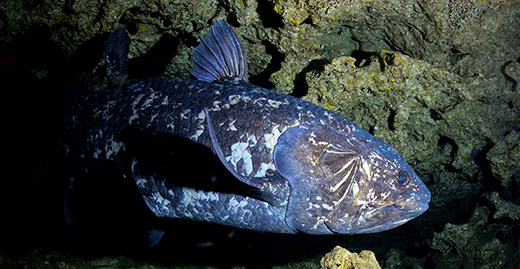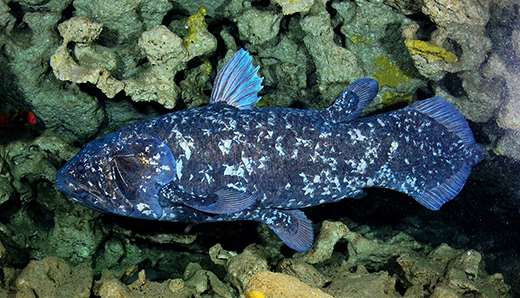 KM-One Special Project【シーラカンスプロジェクト】
KM-One Special Project【シーラカンスプロジェクト】生ける化石とも言われている「シーラカンス」は1938年に南アフリカで発見されました。見つかった姿はなんと、3億6500万年前と変わらぬ姿のままでした。もうすでに絶滅したと考えられていたために、研究者たちはもちろん世界の人々に驚きをもたらしたことは言うまでもないでしょう。現在ではこれまでにアフリカ(南アフリカ・コモロ諸島・タンザニア)とインドネシアで見つかっています。「シーラカンス」は地球環境を象徴する重要な研究素材で、老若男女問わず多くの年齢層に知られており関心が高い生物です。

「シーラカンス」の仲間の化石は約80種が分類されています。このうち現在も生きた状態で確認されているのは深海に潜むラティメリア2種のみです。川などに生息していた他の「シーラカンス」は全て絶滅しており、化石のみで見つかっています。では深海に生息する「シーラカンス」はどうして生き残れたのでしょうか。一説によると3億6500万年の間ほぼ変わることのなかった‘深海の環境’によるものだと考えられています。深海生物に「生ける化石」と呼ばれる生物が多いのも同様の理由でしょう。安定した環境下で特異な進化が必要なかったと思われる、ラティメリアに注目することで「シーラカンス」はもとより、深海生物の謎に迫れると考えています。

通常水深152‐243mの間で、火山島の急な岩が多い傾斜から離れた「中間帯」の温帯の海域に生息しており、コモロ諸島では昼間に海底の溶岩洞窟で集まるということが知られ、夜行性であることも分かりました。かつてインドネシアで潜水艦から観察された2例は、水深150m程にある炭酸カルシウムの洞穴で見つかっています。また現在確認されている「シーラカンス」は南アフリカ・タンザニア・インドネシアでいずれも水深は150mと深海です。しかしその中でも南アフリカの目撃例はより浅く91‐120mの間の大陸棚の下にある浅い洞穴で見つかりました。
「シーカンス」の生息域は水深100m以深と深いため、一般的な空気を使ったスキューバダイビングでは潜水が不可能です。しかし1980年初頭にアメリカのNOAAの研究機関として活動を始めたIANTDでは、混合ガスを使った潜水の教育を始め現在ではリブリーザーという特殊な器材を使い、150mまで潜りより安全に再び水面へ帰ることも可能になりました。この技術は今までのスキューバダイビングより高度なため、ダイバー自身の知識・潜水技術も高いレベルを要求されます。この訓練の厳しさはNASAの宇宙船外活動を行う飛行士とほとんど変わりないと言っても過言ではありません。そうして潜水艇では見つけることが出来なかった「シーラカンス」を、この高度なテクニカルダイビング技術のおかげで発見することが出来、生息域での撮影が可能になったのです。 このように深く潜ることを諦めなかった探究者たちが居たからこそ、生ける化石「シーラカンス」と出会うことが出来ました。四足動物の祖先・神秘の生物「シーラカンス」に迫ることでこれからの私たちの未来の発展になると信じています。美しくも儚い海の素晴らしさを21世紀の子供たちへ、また夢をみることを忘れてしまった大人たちに見てほしい、と思い私たちは立ち上がります。そして挑戦することの大切さ、1つのことを最後までやり遂げる粘り強さ、夢を持つことの情熱と素晴らしさを届けます。
最新の撮影機材‘VRカメラ’および‘4K動画カメラ’による定点行動記録撮影を行います。これらのカメラを用いて昼間の生態観察だけでなく、かつてない夜間の生態観察に挑みます。また水温・水流・流速などの生息環境や海洋条件の把握、「シーラカンス」の生息水深帯に出現する動物(主に魚類)層の把握をします。 そして何故「シーラカンス」が住む水深に潜ることが容易ではないのか、またどうすれば潜水が可能なのかについて、IANTD JAPANの技術と教育を中心に‘ヘリウムガスを混合した呼吸ガスを使う潜水が、空気を使う通常の潜水とどう違うのか’を解き明かしていきます。リブリーザーという最新器材の情報や最新潜水技術と教育のプロセスを映像化し、国内だけでなく世界に発信することで「シーラカンス」はもちろんのこと、海洋や潜水技術に対する興味を全世界の人から引き出したいと考えています。
SERCH FOR LIVING FOSSIL IN TWILIGHT ZONE -Coelacanth filming by latest high deep diving technique and by hypersensitive camera-
Some notes on Coelacanth
So called living fossil “Coelacanth, Latimeria chalmunae” discovered 1938 and described by JLB Smith. The out looking is almost identical with the ancestral form of some three hundred million years before. Because of lacking record of fossil for the recent sixty five million years, Coelacanth was regarded as an extinct group to be extinct up to that time. The discovery of the extant individual was, then shocked much not only scientists but usual citizens at that time. Moreover the second species of the same group, Latimeria menadoensis was found and reported from Indonesia in 1997. The recent discovery of the species in nature by Peter Timm by underwater diving in 2000 at Sodwana Bay, South Africa shocked people again. Search for the living individual for these species by ROV (remote operating vehicle) has been eagerly tried and at present, their appearance is recognized from Tanzania, Comoro Islands, and South Africa for L. chalmunae and from Sulawesi and Papua New Guinea for L. menadoensis. More than 300 individuals have been caught accidentally up to now by fishermen. The living Coelacanth is regarded as an important symbol of the planet Earth environment, and have been received interest of citizens of all generations. The oldest Coelacanth fossil was recorded from late Devonian, 365 million years ago. They thrived early Triassic (248-242 million years ago) at shallow sea and some groups entered even to freshwater zone. Most species had been extinct up to Late Cretaceous (100my). And the recent Cenozoic formation (65million years ago up to present) lacks fossil of the Coelacanth. This lack of the fossil record resulted belief of the extinction of the group up to the Smith’s report of 1938.
The reason why they survived?
Fossil Coelacanth are known from about 80 species, but the extant species includes two species, viz Latimeria chalmunae and L. menadoensis. They hide themselves in the sheltered lava-caves. Their preference water temperature ranges from 14-21°C at Indonesian waters, 16.5-22.8°C at Comoros, and below 16-19°C at South African waters. They seem to have chosen this rather peaceful habitat with less competition without other voracious predators in competition. This relatively stable environment of twilight zone, like other living fossils of deep sea, made it possible to survive that Latimeria could to survive through its long geological history with less change in morphology. Focussing on observation for this species, we can expect various features of the living fossils for their conservation.
Habitat of Coelacanth
Observation by submarine for Comoro’s population, they rest lava-caves in small numbers at daytime and at night, they drift singly for search for prey at steep lava-slope. They appear layers between ca100 to 250m. While at Indonesian water, they rest caves at layers of 150m or more. The population of South Africa, they are observed at shallower caves of layers between 91 to 120m deep.
Why Coelacanth?
Because of their deeper water appearance, we cannot observe Coelacanth with use of usual SCUBA. From early 1980’s, IANTD started it’s activity for deep water diving as a branch of NOAA and started training deep diving with rebreather charged with mixed gasses. Nowadays it became possible to dive at 150m deep and return surface without any trouble. Because of highly sophisticated tool than usual SCUBA diving, this method requires much knowledge and high technique for the divers of themselves. The severe training is comparable with extravehicular activity of astronauts. This high tech made it possible to encounter with Coelacanth. Because of their exploring spirit brought the real encounter and direct observation on the living fossil. Knowing mysterious coelacanth as the ancestor of the tetrapods, we do believe to get clues for future of all living creatures. We stand up to tell the sea, magnificent but with fragility together with living creatures of it, not only for next generation but for citizens lost their dreams. We will be happy to re-evoke the importance of challenging spirit, accomplishment, and to have a dream.
Filming using the latest technology
Using the newest model of “VR camera” and “4K video recorder”, we will monitor coelacanth as long as possible and challenge to record throughout the day, especially at night time which has yet to be clarified. Adding to these, their environmental factors such as water temperature, current velocity and its direction and the fish fauna as food resources or as competitors will be monitored. Using by our technique and educational system of IANTD Japan, we would like to clarify the difficulty and the possibility with safe diving up to the depths of the habitat of Coelacanth. The objective of this point covers clarification of the difference between diving by helium mixed gas and usual air diving. We do hope to evoke passion and interest of the world citizen on coelacanth of course, ocean, and technique for diving through the visualization of the latest technique and educational process of rebreather.